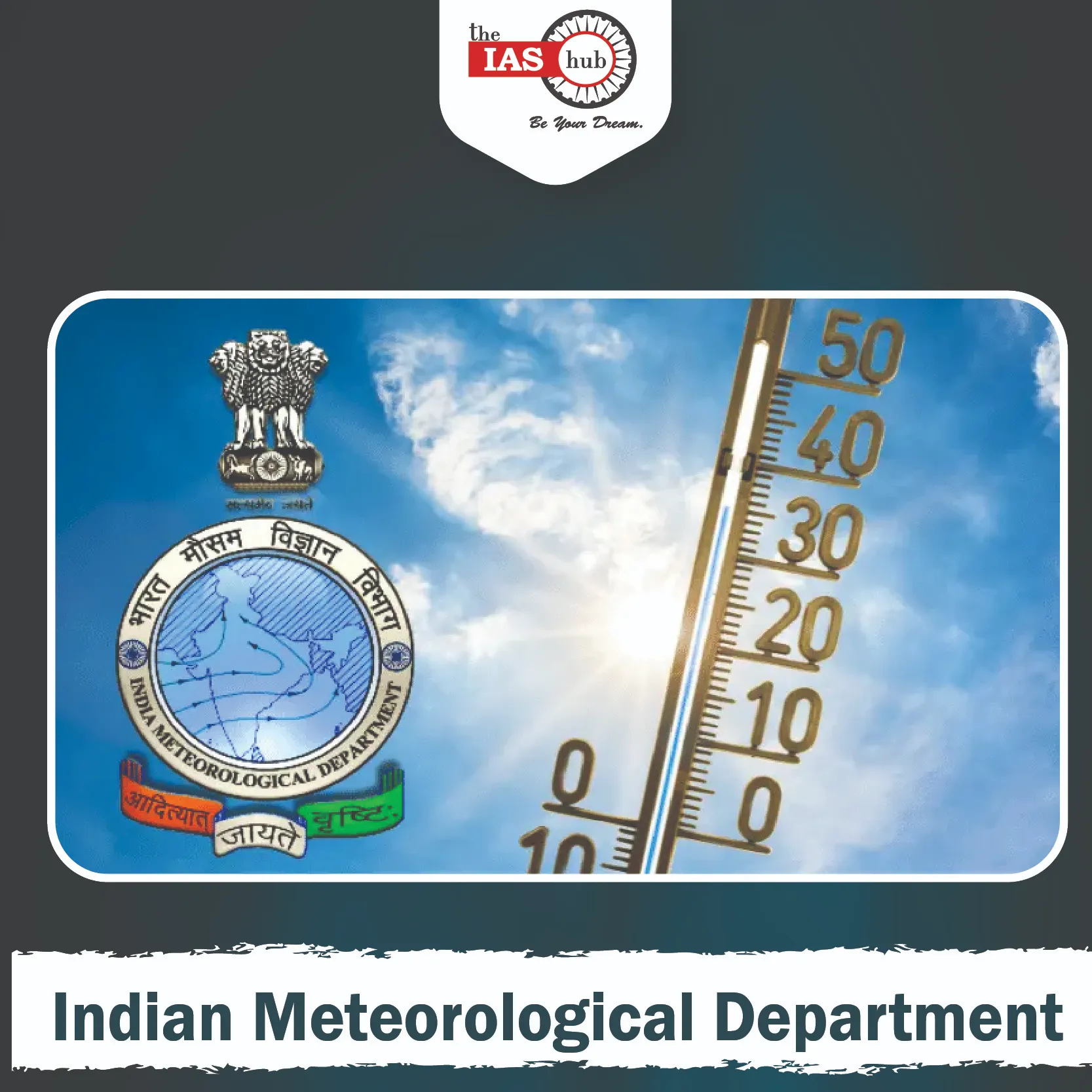Celebrate the 150 years of Indian Meteorological Department (IMD) and explore its journey in weather forecasting, disaster management, and climate research.


India Meteorological Department (IMD) is the cornerstone of India’s weather and climate services. Established on January 15, 1875, IMD has completed 150 years, marking a milestone in its journey of scientific advancement. Operating under the Ministry of Earth Sciences, IMD plays an important role in forecasting weather, monitoring climate, and aiding disaster management.
150th anniversary of the Indian Meteorological Department (IMD) was celebrated on January 15, 2025, at Bharat Mandapam in New Delhi. During this special occasion, Prime Minister Narendra Modi introduced the IMD Vision 2047 and launched Mission Mausam.
| Overview of India Meteorological Department | |
| Date of Established | January 15, 1875 |
| IMD Headquarters | Mausam Bhavan, Lodhi Road, New Delhi |
| Ministry | Ministry of Earth Sciences |
| Regional Offices | Chennai, Mumbai, Kolkata, Nagpur, Guwahati, New Delhi |
| Services provided by IMD | Rainfall Information, Monsoon, Cyclone, Agromet, Climate Services, Urban Meteorological Services, Aviation Services, Climate Hazard & Vulnerability Atlas, Geospatial Services |
| Responsibilities | Meteorological observations and forecasting
Severe weather warnings (e.g., cyclones, storms) Support for agriculture, aviation, shipping, etc. Earthquake monitoring and research in meteorology and allied subjects |
| Key Initiatives | System of Aerosol Monitoring and Research (SAMAR)
Collaboration with ISRO for satellite data utilization |
| Specialization | One of six Regional Specialized Meteorological Centres of the World Meteorological Organization |
| Director General | Mrutyunjay Mohapatra |
| Website | mausam.imd.gov.in |
The Indian Meteorological Department (IMD) was established on January 15, 1875, in response to severe weather events like the 1864 tropical cyclone in Calcutta and recurring monsoon failures, which underscored the necessity for a centralized weather monitoring system.
Initially, IMD focused on basic weather observations and data collection. By the early 20th century, it expanded its network of observatories across India, significantly enhancing localized weather predictions. Over time, IMD continuously upgraded its capabilities by adopting advanced technologies such as Doppler radar systems, satellite imagery, and modern weather prediction models.
Today, the India Meteorological Department stands as a global leader in meteorological services, providing critical insights into weather and climate for diverse sectors while strengthening disaster management and resilience.
The India Meteorological Department, commonly referred to as IMD, is India’s national weather agency. Its primary responsibilities include:
The India Meteorological Department has made significant progress in weather forecasting and disaster management over its 150-year history, adapting to new technologies and challenges. Here are some of the key achievements of IMD over the years:
The role of the Indian Meteorological Department (IMD) is to provide weather forecasts, track climate changes, and give early warnings about natural disasters. It helps farmers, airlines, and disaster management teams to plan better and stay safe. IMD’s functions are pivotal to multiple sectors which include:
The IMD plays a crucial role in disaster management by providing early warnings for severe weather events like cyclones and floods. The Role of IMD in Disaster Management include:
The achievements of the Indian Meteorological Department (IMD) include improving weather forecasts, expanding radar networks, and reducing cyclone-related deaths. It has also developed tools to engage the public and improve weather prediction accuracy. Some of its achievements include:
The IMD Vision 2047 document outlines the roadmap for India’s weather resilience and adaptation to climate change as the nation nears its 100th year of independence. The vision prioritizes advancements in weather forecasting, disaster management, and climate action over the next few decades. Some of the key objectives outlined in this vision include:
Mission Mausam launched on the sidelines of Vision 2047. It focuses on making India a climate-smart nation. 150th anniversary of the Indian Meteorological Department (IMD). Key Highlights of Mission Mausam include:
In conclusion, the India Meteorological Department has been a pillar of resilience and innovation for 150 years. From weather forecasting to disaster management, its contributions have saved countless lives and strengthened India’s preparedness. As IMD looks forward to 2047 with Vision 2047 and Mission Mausam, it reaffirms its commitment to building a climate-smart and disaster-resilient nation.
To learn more about the Indian Meteorological Department (IMD) and its scope in Indian Climate Forecasting, and various other important institutions from the perspective of UPSC exams, explore IAS Hub Courses for the upcoming UPSC Prelims 2025 and Mains Exam.
| Related Articles | |
| Guru Gobind Singh Jayanti | National Sports Award 2024 |
| Makar Sankranti 2025 | Indian Army Day |
The Indian Meteorological Department was established on January 15, 1875, marking the beginning of India’s centralized weather services.
The IMD headquarters is located in New Delhi, India, at Mausam Bhavan.
The role of IMD in disaster management includes providing timely weather warnings for cyclones, floods, and other natural disasters, helping to reduce risks.
The India Meteorological Department uses tools like Doppler radar, satellite imagery, and weather prediction models to provide accurate weather forecasts.


Refine your answer writing skills and elevate your UPSC preparation with personalized support and expert feedback.
Fill out the form to get started with the program or any other enquiries !








Are you dreaming of becoming an IAS officer? Then, IAShub can be your best guide. It is one of the Best IAS Coaching in Delhi. Many students who want to clear the UPSC exam join IAShub for learning. The institute gives both online and offline classes. Their teachers are experienced and helpful. They easily explain every topic. Students also get notes, tests, and tips to do well in the exam.
IAShub is in Delhi and is trusted by many UPSC students. It offers coaching for every part of the UPSC exam – Prelims, Mains, and Interview. The classes are simple and easy to understand. The teachers are experts and guide students in the right way. IAShub is also known for its helpful notes, test series, and answer-writing practice. IAShub is the best coaching in Delhi and also gives UPSC Online Classes. This helps students from any place in India to learn. The online classes are live and also recorded. So, students can watch them anytime. These classes cover the full UPSC syllabus.
Here are some important services provided by IAShub:
The UPSC Civil Services Exam has three parts:
This exam is tough, but with the right guidance, it becomes easy to manage. Students must study smart and stay regular.
IAShub supports students from the beginning to the end. It gives the right books, tests, and notes. The classes are easy to follow, and the teachers are always ready to help. Students get personal doubt sessions too. The test series and answer checking help students learn where they need to do better. Also, free study materials save time and money.
IAShub also guides students during the final stage – the interview. Experts take mock interviews and give useful tips. This full support makes IAShub one of the best IAS coaching in Delhi.
